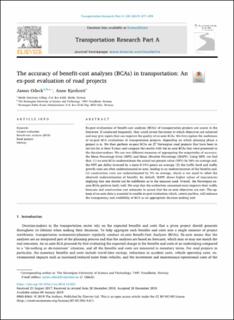| dc.contributor.author | Odeck, James Oyugi | |
| dc.contributor.author | Kjerkreit, Anne | |
| dc.date.accessioned | 2023-10-10T10:53:33Z | |
| dc.date.available | 2023-10-10T10:53:33Z | |
| dc.date.created | 2019-01-16T08:40:00Z | |
| dc.date.issued | 2019 | |
| dc.identifier.citation | Transportation Research Part A: Policy and Practice. 2019, 120 (February), 277-294. | en_US |
| dc.identifier.issn | 0965-8564 | |
| dc.identifier.uri | https://hdl.handle.net/11250/3095459 | |
| dc.description.abstract | Ex-post evaluations of benefit-cost analyses (BCAs) of transportation projects are scarce in the literature. If conducted frequently, they could reveal the extent to which objectives are achieved and may give inputs that can improve the quality of ex-ante BCAs. We first explain the usefulness of ex-post BCA evaluations of transportation projects, depending on which planning phase a project is in. We then perform ex-post BCAs on 27 Norwegian road projects that have been in service for at least 5years and compare the results with the ex-ante BCAs that were presented to the decision-makers. We use two different measures of aggregating the magnitudes of accuracy; the Mean Percentage Error (MPE) and Mean Absolute Percentage (MAPE). Using MPE, we find that: (1) ex-ante BCAs underestimate the actual net present value (NPV) by 50% on average and, the NPV per dollar invested by a mere 0.14% points on average; (2) the traffic level and traffic growth rates areoften underestimated ex-ante, leading to an underestimation of the benefits and; (3) construction costs are underestimated by 5% on average, which is too small to offset the observed underestimation of benefits. By default, MAPE shows higher values of inaccuracies implying that one should not be indifferent as to the measure used. Overall, the Norwegian exante BCAs perform fairly well. We urge that the authorities concerned must improve their traffic forecasts and construction cost estimates to assure that the ex-ante objectives are met. The upkeep of ex-ante data is essential to enable ex-post evaluation which, ceteris paribus, will enhance the transparency and credibility of BCA as an appropriate decision-making tool. Keywords: ex-post evaluation, benefit-cost analyses (BCA), road projects, Norway | en_US |
| dc.language.iso | eng | en_US |
| dc.relation.uri | https://doi.org/10.1016/j.tra.2018.12.023 | |
| dc.rights | Attribution-NonCommercial-NoDerivatives 4.0 Internasjonal | * |
| dc.rights.uri | http://creativecommons.org/licenses/by-nc-nd/4.0/deed.no | * |
| dc.title | The accuracy of benefit-cost analyses (BCAs) in transportation : an ex-post evaluation of road projects | en_US |
| dc.type | Peer reviewed | en_US |
| dc.type | Journal article | en_US |
| dc.description.version | publishedVersion | en_US |
| dc.source.pagenumber | 277-294 | en_US |
| dc.source.volume | 120 | en_US |
| dc.source.journal | Transportation Research Part A: Policy and Practice | en_US |
| dc.source.issue | February | en_US |
| dc.identifier.doi | 10.1016/j.tra.2018.12.023 | |
| dc.identifier.cristin | 1657795 | |
| cristin.ispublished | true | |
| cristin.fulltext | original | |
| cristin.qualitycode | 2 | |

